The main research topics of SCNL are related to Non-Terrestrial Networks (NTN) and Cybersecurity.
In detail, the main research activities currently addressed are:
Non-Terrestrial Networks (NTN)
NTN integration in B5G / 6G
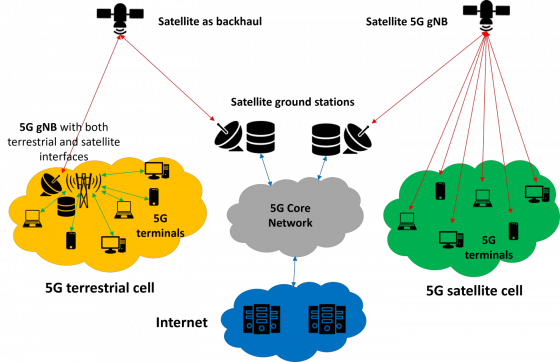
Non-Terrestrial Networks (NTN) became a viable solution to improve the current Internet connectivity in the vision of the Beyond 5G (B5G) / 6G frameworks. Satellites, UAVs, and HAPS can offer higher coverage, reliability, and extend Internet connection to rural and remote areas where there is no other kind of telecommunication infrastructure (and the cost to build a terrestrial network from scratch would be prohibitive).
However, the employment of networking solutions designed and developed for terrestrial networks is not straightforward.
Involved people: Nour Badini, Fabio Patrone, Mario Marchese
Related projects and collaborations:
- Data-driven Network Controller and Orchestrator for Real-time Network Management (ANChOR), European Space Agency ESA/ESTEC Contract No.: 4000131447/20/NL/AB, 2020-2022.
Publication results:
- The Role of Satellite in 5G and Beyond, book chapter of "A Roadmap to Future Space Connectivity", Springer, 2023.
- NS-3-based 5G Satellite-Terrestrial Integrated Network Simulator, IEEE MELECON, Palermo, Italy, 2022.
- AI for Zero-Touch Management of Satellite Networks in B5G and 6G Infrastructures, International Workshop on Artificial Intelligence in Beyond 5G and 6G Wireless Networks (AI6G), Padua, Italy, 2022.
- Data-driven Network Orchestrator for 5G Satellite-Terrestrial Integrated Networks: The ANChOR Project, IEEE Global Communications Conference (GLOBECOM), Madrid, Spain, 2021.
- Nanosatellite-5G Integration in the Millimeter Wave Domain: A Full Top-Down Approach, IEEE Transactions on Mobile Computing, vol. 19, no. 2, pp. 390 - 404, 2020.
- Networking Challenges for Non-Terrestrial Networks Exploitation in 5G, IEEE 5G World Forum (5GWF), Dresden, Germany, 2019.
- IoT and UAV Integration in 5G Hybrid Terrestrial Satellite Networks, MDPI Sensors, Volume 19, Issue 17, Article Number 3704, 2019.
Routing and Handover in Mega-LEO satellite networks
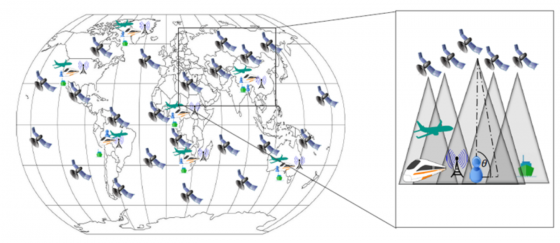
Industries and companies such as SpaceX, OneWeb, and Amazon, are designing and launching constellations made of thousands of Low Earth Orbit (LEO) communication satellites to contribute building a universal “Space Internet” able to support the classical and legacy terrestrial Internet. However, a lot of challenges from several viewpoints are still open, such as how to route the information throughout this network and how to manage the handover mainly caused by the fast-moving LEO satellites considering the strict hardware constraints of these space nodes.
Involved people: Nour Badini, Fabio Patrone, Mario Marchese
Related projects and collaborations:
- Collaboration with prof. Mona Jaber, Queen Mary University, London, UK.
Publication results:
- User Centric Satellite Handover for Multiple Traffic Profiles Using Deep Q-Learning, IEEE Transactions on Aerospace and Electronic Systems, 2024
- Intelligent Space Communication Networks, book chapter of "A Roadmap to Future Space Connectivity", Springer, 2023.
- Energy-Aware Satellite Handover Based on Deep Reinforcement Learning, IEEE Global Communications (GLOBECOM) conference, Kuala Lumpur, Malaysia, 2023.
- Reinforcement Learning-Based Load Balancing Satellite Handover Using NS-3, IEEE International Communication Conference (ICC), Rome, Italy, 2023.
Orbital Edge Computing
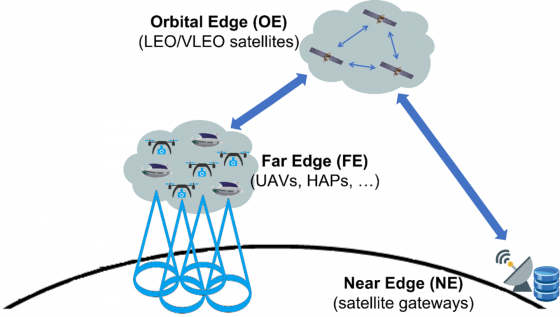
Mega-LEO satellite constellations are becoming a reality. Thousands of LEO satellites are orbiting the Earth mainly to offer worldwide Internet access, even if next-generation satellites could be also exploited for something else. Terrestrial users can benefit from offloading computational tasks to Orbital Edge Computing (OEC) platforms where tasks are processed onboard satellites.
However, further improvements are still achievable considering multiple aspects, such as how to perform the computing sharing in this distributed orbital platform and which network information can be used.
Involved people: Camilo Jose Rojas, Fabio Patrone, Mario Marchese, Franco Davoli
Related projects and collaborations:
- Collaboration with prof. Juan Fraire, Institut National de Recherche en Informatique et en Automatique (INRIA), Lion, France
- Collaboration with Dr. Alberto Gotta and Dr. Pietro Cassarà, Istituto di Scienza e Tecnologie dell’Informazione (ISTI) of the Italian National Research Council (CNR), Pisa, Italy
Publication results:
- Advanced Constellation Emulation and Synthetic Datasets Generation for Non-Terrestrial Networks, IEEE International Mediterranean Conference on Communications and Networking (MeditCom), Madrid, Spain, 2024.
- Fuzzy Logic-Based Orchestration of Multi-Access Edge Computing in LEO Satellite Constellations, IEEE International Conference on Communications (ICC), Denver, USA, 2024.
- Continuous Time Emulation for Software-Defined Non-Terrestrial Edge Computing Networks, European Wireless Conference, Rome, Italy, 2023.
- Performance Evaluation of a Satellite Communication-based MEC architecture for IoT applications, IEEE Transactions on Aerospace and Electronic Systems, 2022.
- Flow Assignment and Processing on a Distributed Edge Computing Platform, IEEE Transactions on Vehicular Technologies (TVT), 2022.
- Orbital Edge Offloading on Mega LEO Satellite Constellations for Equal Access to Computing, IEEE Communications Magazine, 2022
Cybersecurity
UAV for localization and anomaly detection in IoT scenarios
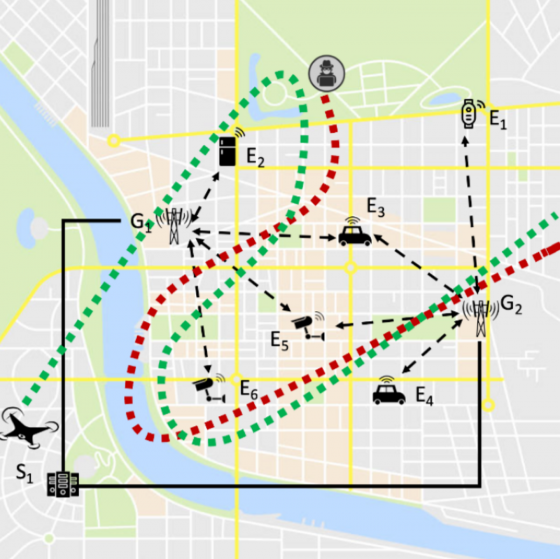
Unmanned Aerial Vehicles (UAVs) are deployed and used for multiple purposes. One of them is related to telecommunication and involves properly equipped UAVs to fly above certain areas in order to collect data sent by underlying IoT nodes. This application has its role especially in rural areas but also in urban scenarios, if these flying nodes are exploited for additional tasks, such as cybersecurity-related tasks.
However, multiple technological aspects still have to be considered and addressed to properly unleash the full potential of these devices, considering the different kinds of information they can collect and how they can interact with the other terrestrial and non-terrestrial network nodes.
Involved people: Zhansaya Amangeldiyeva, Fabio Patrone, Sandro Zappatore, Mario Marchese
Related projects and collaborations:
- FOLLOWME – Flying drOnes to Locate cyber-attackers in LOraWan Metropolitan nEtworks, Progetto di ricerca di Rilevante Interesse Nazionale (PRIN), 2023-2025.
Publication results:
- UAV-based LoRaWAN flying gateway for the internet of flying things, Wiley International Journal of Communication Systems, Article Number e5421, 2022.
- Comparison between UAV IoT solutions with and without satellite backhaul link without satellite backhaul link, IEEE Aerospace Conference, Big Sky, Montana, USA, 2022.
- UAV and satellite employment for the Internet of Things use case, IEEE Aerospace Conference, Big Sky, Montana, USA, 2020.
- Towards increasing the LoRa network coverage: A flying gateway, International Symposium on Advanced Electrical and Communication Technologies (ISAECT), Rome, Italy, 2019.
- UAV and IoT Integration: A Flying Gateway, IEEE International Conference on Electronics, Circuits and Systems (ICECS), Genoa, Italy, 2019.
Security assessment of systems with wireless communication interfaces
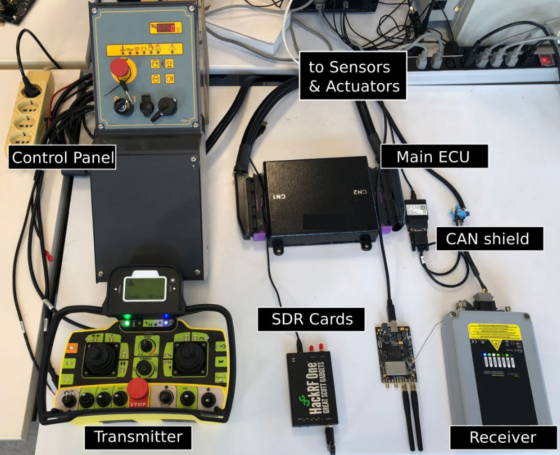
Nowadays, a higher number of systems are equipped with ICT technologies to improve them and offer additional functionalities to authorized users. Such improvements made these systems generate more data and connect to the Internet to allow authorized personnel to remotely see these data and manage the related apparatus.
However, the cybersecurity aspect is often underestimated, making these systems suffer from cyber threats and vulnerabilities that can be exploited by malicious users. An important aspect is to develop a universal tool for the system’s security assessment aims to verify the system’s security level by testing the different possible interfaces that unauthorized people can exploit to make attacks, such as the wireless communication interfaces.
Involved people: Muhammad Saad Sohail, Giancarlo Portomauro, Giovanni Battista Gaggero, Fabio Patrone, Mario Marchese
Related projects and collaborations:
- VALU3S - Verification and Validation of Automated Systems’ Safety and Security, EU H2020-ECSEL-2019-2-RIA, 2020-2023.
- Resilient Trust - Trusted SMEs for Sustainable Growth of Europeans Economical Backbone to Strengthen the Digital Sovereignty, EU HORIZON-KDT-JU-2022-2-RIA, 2023-2026.
- Collaboration with Aitek and Istituto di Elettronica e di Ingegneria dell’Informazione e delle Telecomunicazioni (IEIIT) of the Italian National Research Council (CNR)
Publication results:
- Vulnerability Assessment of Industrial and Agricultural Control Systems within the IoT Framework, book chapter of "Intelligent Computing on IoT 2.0, Big Data Analytics, and Block Chain Technology", CRC Press, 2024.
- An SDR-Based Cybersecurity Verification Framework for Smart Agricultural Machines, IEEE Access, Volume 11, Pages 54210-54220, 2023.
- A Framework for Network Security Verification of Automated Vehicles in the Agricultural Domain, IEEE ELECTRONICS, Palanga, Lituania, 2022.
- A Proposal for the Classification of Methods for Verification and Validation of Safety, Cyber security, and Privacy of Automated Systems, Conference on the Quality of Information and Communications Technology (QUATIC), Online, 2021.
Anomaly detection in Industrial Control Systems
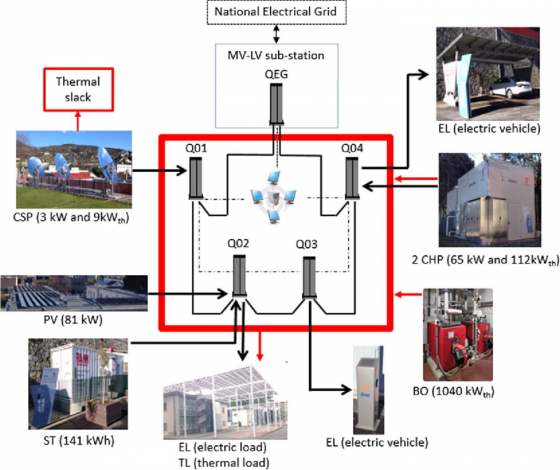
Smart Grids represent the new paradigm of evolution of electricity grids. Power grids implement a growing variety of control systems based on ICT technologies to meet the needs of real-time monitoring and control. Distributed energy sources, storage systems, and Vehicle-to-Grid provide the main examples. This evolution significantly extends the attack surface. The action of smart-grid protection must be approached from different perspectives, including Network Security and Cyber-physical security, starting from the observation that the control networks themselves carry information on the physical behavior of a process and for this reason they must respect the laws of physics that govern the process itself. An anomaly can, therefore, be identified as a particular operational condition of the infrastructure as a whole, including both the network of controllers and the controlled process.
The aim is the development of monitoring algorithms relying on an integrated approach that can significantly benefit from the use of Machine Learning (ML), which plays a crucial role.
Involved people: Afroz Mokarim, Faraz Bashir, Giovanni Battista Gaggero, Mario Marchese
Related projects and collaborations:
- Smart Grid Cyber-Physical Security (SCS), Piano Nazionale di Ripresa e Resilienza (PNRR) – Italian National Recovery fund, Partenariato esteso “Security and Rights in CyberSpace - SERICS”, 2023-2025.
- Robotics and AI for Socio-Economic Empowerment (RAISE), - Piano Nazionale di Ripresa e Resilienza (PNRR) – Italian National Recovery fund, Ecosistema dell’innovazione, 2023-2025.
- Physical and Cyber Security Information, event management & correlation (Phy.Cy.SIEMC), regional project Start 4.0 as subcontractor of Sababa Security, 2020-2021.
- Gestore Avanzato di Scambi di Potenza in Alta Tensione per reti Energetiche della Difesa, Piano Nazionale della Ricerca Militare (PNRM) – ITER, 2020-2021.
- Cyber Security delle infrastrutture critiche (CYBIC), regional project of Polo SOSIA as subcontractor of Circle, 2019-2021.
Publication results:
- BESS-Set: A Dataset for Cybersecurity Monitoring in a Battery Energy Storage System, IEEE Open Access Journal of Power and Energy, 2024.
- Should We Include Cyberdefense Functionalities in Electrical Power System Protections?: A Proposed Approach, IEEE Industrial Electronics Magazine, 2024.
- Industrial Control System-Anomaly Detection Dataset (ICS-ADD) for Cyber-Physical Security Monitoring in Smart Industry Environments, IEEE Access, Volume. 12, pp. 64140 - 64149, 2024.
- Impact Analysis of Cyber Attacks against Energy Communities in Distribution Grids, Electronics, Volume. 13, Issue 9, Article number 1709, 2024.
- Detecting Cyberattacks on Electrical Storage Systems through Neural Network Based Anomaly Detection Algorithm, MDPI Sensors, Volume 22, Issue 10, Article number 3933, 2022.
- Toward the Integration of Cyber and Physical Security Monitoring Systems for Critical Infrastructures, MDPI Sensors, Volume 21, Issue 21, Article number 6970, 2021.
- Advancements and Research Trends in Microgrids Cybersecurity, MDPI Applied Sciences, Volume 11, Issue 16, Article Number 7363, 2021.
- Detecting System Fault/Cyberattack within a Photovoltaic System Connected to the Grid: A Neural Network-Based Solution, MDPI Journal of Sensor and Actuator Networks, Volume 9, Issue 2, Article Number 20, 2020.
Satellite Cybersecurity
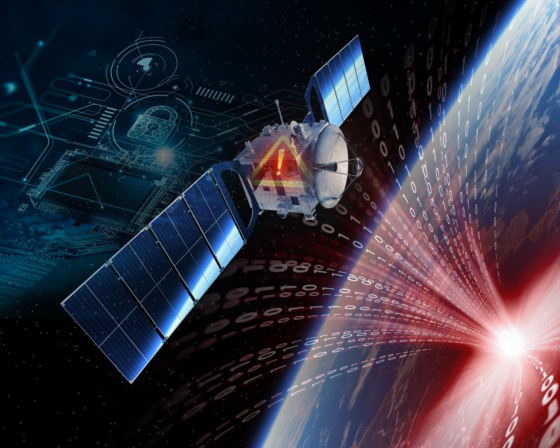
Recent competitions and challenges, such as Hack-A-Sat (https://hackasat.com/), showed how satellite systems can be appealing to hackers and prone to cyber-attacks, ranging from the simple satellite service disruption to the more dangerous partial or full control of the deployed satellites.
However, simply applying protection systems designed and used in terrestrial networks may not be an always applicable and useful solution. Besides, proper training of the satellite users and operators is needed to allow them to properly consider this aspect and implement the fundamental security-by-design principle.
Involved people: Nour Badini, Giancarlo Portomauro, Fabio Patrone, Mario Marchese
Related projects and collaborations:
- OpenSatRange: Un cyber range aperto per la formazione in cyber security di operatori di sistemi e reti satellitari, Giornate della ricerca accademica spaziale, Area Tematica del Tavolo di Cyber security, Italian Space Agency (ASI), 2023-2025.
Publication results:
- OpenSatRange: An Open Cyber Range for Operators and Users of Satellite Communication Networks, Italian Conference on CyberSecurity (ITASEC), Salerno, Italy, 2024.